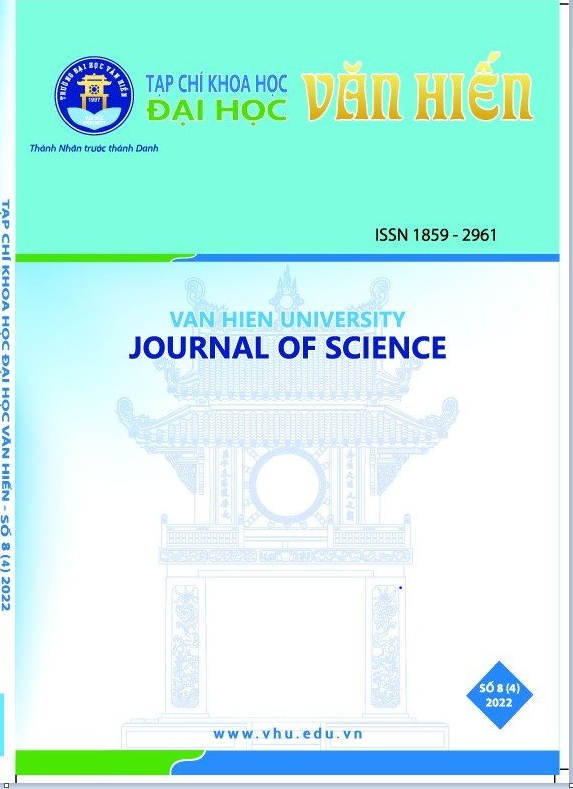Kobayashi Issa: A pioneer in the popularization of Haiku with a strong sense of self
Main Article Content
Abstract
Article Details
References
Blyth, R.H. (1981). Haiku Volume 1: Eastern Culture. Japan, The Hokuseido Press.
Bộ Giáo dục và Đào tạo (2008). Sách Giáo khoa Ngữ văn 10, Tập Một. Hà Nội, Nxb Giáo dục.
Đoàn Lê Giang (2017). Cảnh sắc và tâm hồn Việt qua con mắt haiku. Thơ haiku Việt - Nhật 2017 Cuộc thi sáng tác thơ haiku Việt - Nhật lần thứ 6. Tp. Hồ Chí Minh, Nxb Đại học Quốc gia Tp. Hồ Chí Minh.
Fuji, K. (1998). 俳句の授業・俳句の技法 どう教え どう作るか. Giờ dạy thơ Haiku - thi pháp thơ Haiku - cách dạy và cách làm thơ. Nhật Bản, Nxb Meiji Tosho Co.
Ikezawa, N. (2016). 日本文学全集12. Tuyển tập Văn học Nhật Bản số 12. Nhật Bản, Nxb Kawade Shobo Shinsha.
Kaneko, T. (2014). 小林一茶 句による評. Lời bình luận từ câu thơ của Kobayashi Issa. Nhật Bản, Nxb Iwanami Gendai Bunko.
Kato, S. (1994). Japan Spirit & Form. US, Charles E. Tuttle Company.
Kato, S. (2001). 一茶秀句. Tuyển tập thơ Issa. Nhật Bản, Nxb Shunjusha.
Kenneth, Y. (1982). Japanese Haiku: Its Essential Nature, History, and Possibilities in English, With Selected Examples. US, Charles E. Tuttle Company.
Konishi, J. (2002). 発生から現代まで俳句の世界.Thế giới thơ Haiku từ khởi sinh đến hiện đại. Nhật Bản, Nxb Kodansha.
Maeda, A., và Hasegawa, I. (Chủ biên) (1990). 日本文学新史(近代). Sử mới văn học Nhật Bản (Cận đại). Nhật Bản, Nxb Shibundo.
Matsuda, H. (2008). 一番やさしい俳句再入門. Tái nhập môn thơ Haiku dễ nhất. Nhật Bản, Nxb Daisan Shoten.
Matsuda, O. (Chủ biên) (1986). 日本文学新史 近世. Sử mới văn học Nhật Bản, Cận Thế. Nhật Bản, Nxb Shibundo.
Matsuoka, M., Akabane, M., và Maruyama, K. (1988). 俳諧の表現. Biểu cảm thơ Haiku. Nhật Bản, Nxb Kyoiku Shuppan Center.
Nobuyuki, Y. (1972). The Year of My Life - A translation of Issa’s Oraga Haru. Berkeley and Los Angeles: University of California Press.
Nguyễn Vũ Quỳnh Như (Chủ biên, Giới thiệu) và Vũ Đoàn Liên Khê dịch (2015). Thơ Haiku Nhật Bản: Lịch sử phát triển và đặc điểm thể loại. Tp. Hồ Chí Minh, Nxb Đại học Quốc gia Tp. Hồ Chí Minh.
Nguyễn Vũ Quỳnh Như (Chủ biên) (2019). Luật thơ Haiku (Dịch). Tp. Hồ Chí Minh, Nxb Đại học Quốc gia Tp. Hồ Chí Minh.
Oshiki, Z. (1999). 小林一茶歳時記. Từ điển Quý ngữ của thơ Kobayashi Issa. Nhật Bản, Nxb Kobundo Shuppan.
Otsuka, E. (2020). 日本大衆文化史は可能なのか。日文研大衆文化研究プロジェクト . Can a History of Japanese Popular Culture Exist? In Otsuka, E., Komatsu, K., Yasui, M., Su, H.A., Araki, H., Liu, J., Nichibunken Popular Culture Research Series. Japan, Kadokawa. http://doi.org/10.15055/00007793
Shimizu, T. (1976). 日本古典文学第32巻 蕪村・一茶. Văn học cổ điển Nhật Bản, Cuốn 32. Buson, Issa. Nhật Bản, Nxb Kadokawa Shoten.
Toshinori, T. (2007). 季語集. Tuyển tập quý ngữ. Nhật Bản, Nxb Iwanami Shoten.
Yamashita, K. (1998). 俳句への招待. Xin mời đến với thơ haiku. Nhật Bản, Nxb Shogakukan.



